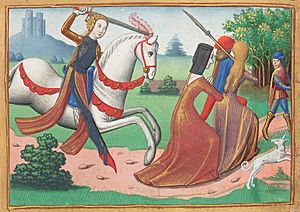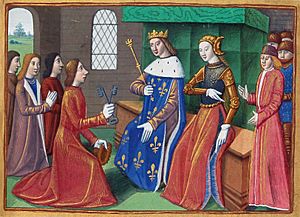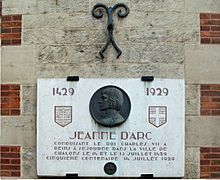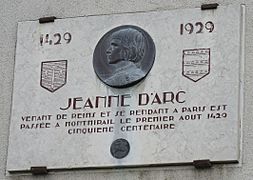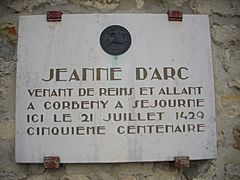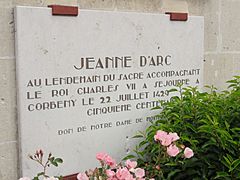March to Reims facts for kids
Quick facts for kids March to Reims |
|||||||
|---|---|---|---|---|---|---|---|
| Part of the Hundred Years' War | |||||||
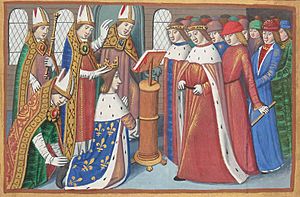 Coronation of Charles VII in Reims (miniature from the Vigiles du roi Charles VII (Vigils of King Charles VII) by Martial d'Auvergne, Paris, BnF, Manuscripts department). |
|||||||
|
|||||||
| Belligerents | |||||||
| Commanders and leaders | |||||||
|
|
|
||||||
After the French army, led by Joan of Arc, won big victories at Orléans and Patay, the English and their allies, the Burgundians, were no longer a major threat. Joan of Arc convinced Charles, who was known as the Dauphin (the heir to the French throne), to travel to Reims. This city was important for French kings to be crowned.
Marching their army safely through land controlled by the Burgundians showed that Charles was regaining control of France. This was a big deal because he had been prevented from becoming king by an earlier agreement called the Treaty of Troyes.
Contents
Why the March Was Important
After John the Fearless was killed, the Treaty of Troyes in 1420 said that the king of England, Henry V, would become the king of France. Henry V married the daughter of the French King Charles VI, and their son, Henry VI, was supposed to rule both England and France.
However, Henry V died in 1422 when his son Henry VI was less than a year old. So, John of Lancaster, Duke of Bedford ruled in Henry VI's place. Joan of Arc's arrival and her victories at Orléans and Patay seemed like a miracle. This made many people believe that Charles VII was the true king.
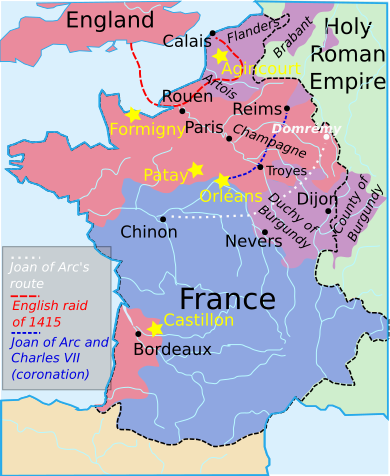
For a long time, the oldest son of the French king always became the next king. But Charles VI of France had tried to stop his own son, Charles, from becoming king. Instead, he wanted Henry VI of England, the son of his daughter Catherine, to rule France.
After Charles VI died, his son Charles said he was the rightful king. Even though the French won the Battle of Patay on June 18, Charles was hesitant to go to Reims. Reims was controlled by the Burgundians, who were against him. He thought about being crowned in Orléans instead. But a coronation in Reims would be much more powerful. It would show everyone that he was the true king, chosen by God.
The Journey to Reims
Joan of Arc first met Charles on May 23, 1429. She met him again on June 21 to convince him to go to Reims. The next day, Charles's advisors decided the army should gather at Gien.
On June 24, Joan of Arc arrived at Gien. She wore her special armor and carried her banner. Charles VII was there to meet her. The next day, 12,000 soldiers joined the king's army at Gien. This brought the total to 33,000 cavalry and 40,000 foot soldiers. The French army quickly took over nearby towns like Bonny-sur-Loire and Saint-Fargeau.
The march to Reims began on June 29, 1429. It was surprisingly easy. This showed how weak the English and Burgundian control was. It also showed that people were starting to believe in Charles VII again. According to Jean de Dunois, a French captain, just showing up was enough to make cities open their gates.
Joan of Arc traveled with many important captains. These included La Hire, André of Lohéac, and Jean Poton de Xaintrailles. On the way, the Burgundian soldiers in Auxerre refused to open their city gates. However, the city remained neutral and allowed the French army to get supplies. The army camped outside the walls on July 1 and 2.
The Dauphin's army continued its march. Saint-Florentin and Brienon l’Archevêque quickly surrendered. On July 4, the army reached Troyes. This city had about 500-600 Burgundian soldiers who refused to open the gates.
The French army laid siege to Troyes for four days. Many of Charles's advisors wanted to give up and move on. But on the fifth day, July 9, Troyes surrendered because they feared an attack. Only Charles VII and his main captains were allowed to enter the city. The soldiers camped outside.
Meanwhile, in Paris, fewer than 2,000 English soldiers were in charge. Philip the Good of Burgundy went to Paris on July 10. He put Jean de Villiers de L'Isle-Adam in charge of Paris's safety. Philip then sent people to Charles to ask for peace.
On July 11, Charles's army left Troyes and headed to Châlons-en-Champagne. This city opened its gates on July 14, allowing the army to stay the night.
On July 16, Philip the Good left Paris. The Archbishop of Reims also left Reims. Charles arrived near Reims and asked the people to open their gates. They had promised to resist him, but after some talks, Charles VII entered Reims and slept there.
The Coronation of Charles VII
On Sunday, July 17, 1429, Charles VII of France was crowned King of France in Reims. The Archbishop Renault Chartres performed the ceremony. Joan of Arc stood by him and said: "Noble King, now God's wish is fulfilled. He wanted me to lift the siege of Orléans. And I have brought you to Reims for your holy coronation. This shows you are the true king, and France must belong to you."
The coronation was simple because of the war. The crown and other royal items were still in English-held Saint-Denis. Only three important church leaders were there. But the anointing, a special part of the ceremony, made Charles the rightful king. It showed he was chosen by God, unlike Henry VI, who was put on the throne by an enemy army.
Remembering the March
To celebrate 500 years since this important march, and because Joan of Arc became a saint, special plaques were placed along the route she took. These plaques mark the cities where Joan and the army passed on their way to Reims.
-
and Reims


